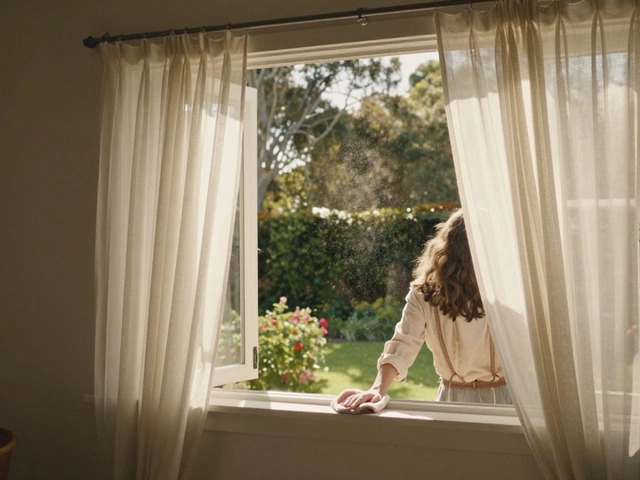Dust. It’s everywhere — lurking on shelves, sneaking onto the tops of picture frames, and even crashing your air quality party without an invite. But let’s get real — how often do you really need to go after it?
To start, dusting isn't just about keeping the place looking sharp. We’re talking air quality here, folks. The dust in your home is a cocktail of stuff like dead skin, pollen, and other particles that can mess with your allergies or even asthma. So, knowing when and how often to dust is like knowing when to trim your hair — it keeps things a whole lot healthier.
Of course, there’s no one-size-fits-all answer. If you live near a busy road or have a household full of pets, you’re likely to need more frequent dust-ups than someone living in a quiet, fur-free zone. But don’t worry, the following sections will arm you with the know-how to customize the perfect schedule for your pad. Let’s roll up our sleeves and tackle this thing together.
- Why Dusting Matters
- The Optimal Dusting Schedule
- Tools of the Trade
- Spotlight on Forgotten Zones
- Quick Tips and Tricks
Why Dusting Matters
You might think of dusting as one of those chores that only matters when company's coming over, but it actually plays a huge role in your day-to-day well-being. Sure, it’s about maintaining a clean look, but it’s also about keeping things healthy—especially when we're talking about air quality at home.
Dust is full of all sorts of particles: dead skin, pollen, mold, and tiny fibers. None of those sound too pretty, right? But beyond looking unsightly, dust can actually stir up trouble for anyone with allergies or asthma. Breathing in this mix can make things uncomfortable and even cause issues like sneezing, itchiness, or more severe respiratory problems.
Health Benefits of Regular Dusting
Think of dusting like a mini-detox for your living space. Keeping dust at bay means you’re not constantly inhaling those pesky particles. For folks with allergies, staying on top of dust control can seriously lower the sneeze factor and let them breathe easier. And for the rest of us? A regular dust routine means cleaner air and maybe even fewer sick days.
Plus, let's not forget that dust can attract more unwanted guests—like dust mites. These little guys love to munch on dead skin cells found in dust. Keeping them away is another reason not to let things pile up.
The Impact on Your Home
Dust doesn’t just affect your health; it can actually wear down your home’s surfaces in the long run. Dust particles act like tiny sandpaper bits, slowly grinding away at your furniture finishes. So, if that wooden coffee table is starting to look a bit tired, maybe it's time to grab that duster.
Consider this an investment in your home maintenance game — regular dusting not only keeps the place looking fresh but also helps your stuff last longer. Now, who wouldn’t want that?
The Optimal Dusting Schedule
Alright, let's break it down. How often should you really bust out those dusters? It's more of a ‘depends on your place’ kind of deal. But don't worry—here's a basic rule of thumb for most homes.
Weekly Dusting
For typical households, a good weekly dust session covers a lot of ground. This includes flat surfaces like tables, shelves, and maybe even your cleaning equipment (ironic, right?). What about your baseboards and door frames? They’re making faces behind your back if you don’t give them some love as well.
Every Two Weeks
Not everything needs constant attention. Things like the undersides of furniture, the tops of ceiling fans, and possibly your blinds might only need dusting every two weeks. These guys just don’t collect as much grime unless your living room doubles as a wind tunnel.
Monthly or Less Often
We’re talking deep corners, the tops of your cabinets, and those hard-to-reach spots. Once a month is usually enough unless you've got an adorable furry friend shedding 24/7. Remember, just because it’s out of sight, shouldn't mean it’s out of mind.
Customized Schedule
Think about the factors that make your home unique. Do you have a pet who’s shedding constantly? More traffic or construction dust due to local conditions? If yes, you might consider more frequent wipe-downs.
| Location | Frequency |
|---|---|
| Flat Surfaces | Weekly |
| Ceiling Fans | Bi-weekly |
| High Cabinets | Monthly |
Understanding your environment's unique needs not only saves you time but also helps keep your home maintenance game strong. Adapt the plan, make it a habit, and maybe dusting won't feel like a chore.

Tools of the Trade
Diving into the world of dusting might seem straightforward, but having the right tools can make all the difference between a quick clean-up and a full-blown cleaning saga. Let’s take a look at what you really need.
Microfiber Cloths
Your first line of defense in the dust war should be a good set of microfiber cloths. Why microfiber? These bad boys are designed to trap dust and hold onto it, rather than just push it around like a basic rag would. Plus, they’re reusable and easy on surfaces.
Feather Dusters
Long handled feather dusters are the Jedi of dusting tools. They’re perfect for those high corners and ceiling fan tops that seem out of reach. Just make sure you give them a shake outdoors after you’re done to lose any clinging dust.
"A quality microfiber cloth can turn an hour of dusting into a manageable ten-minute task," says cleaning expert Susan Gaudreau, founder of Simply Clean. "It’s about working smarter, not harder."
Vacuum Cleaners with HEPA Filters
If you think vacuuming is just for floors, think again. A vacuum with a HEPA filter can suck up dust from all sorts of surfaces. Use the brush attachments for shelves and window ledges — places where dust loves to gather.
Extendable Dusters
These are a must for those pesky ceiling corners or light fixtures. They can extend quite a bit, making climbing on chairs or ladders totally unnecessary.
- Dusting: Every room, every surface can benefit from a different approach.
- Cleaning: Regular maintenance reduces the big clean need.
- Home Maintenance: Tools make it all doable without an exhausting effort.
Each of these tools plays a part in making home maintenance less of a chore and more of a quick routine. With the right gear, spring cleaning becomes a breeze, and who doesn’t want that?
Spotlight on Forgotten Zones
When it comes to dusting, most of us tend to stick to the obvious spots — shelves, coffee tables, the visible areas. But there's a whole world of sneaky places where dust parties like it's got no curfew or parental supervision. These are the zones you might be missing, and they deserve a little attention.
Behind and Under the Furniture
This is an all-time hiding spot for dust bunnies. Even if you don't see it, trust us, it's there. Move couches, tables, and even large appliances if you can. Lenz vacuum extension attachments are your new best friend here.
Ceiling Fans and Light Fixtures
Ever looked up at your ceiling fan or the light fixtures? Yeah, it's time to face the facts. Fans especially love to collect dust and then sprinkle tiny bits of it around your room every time you turn them on.
Window Blinds and Curtains
These guys act like dust magnets, catching all sorts of particles as they float by. A quick run with a microfiber cloth on blinds and a shake or wash of the curtains can work wonders.
Baseboards
Baseboards tend to be overlooked, but they collect a surprising amount of gunk. A quick wipe-down with a damp cloth can keep them looking fresh.
| Forgotten Zone | How Often to Dust |
|---|---|
| Behind Furniture | Monthly |
| Ceiling Fans | Monthly |
| Window Blinds | Biweekly |
| Baseboards | Monthly |
It's all about finding these hidden zones and tackling them with the right tools. Keep this checklist handy and add these areas to your spring cleaning routine to keep your home a dust-free haven.

Quick Tips and Tricks
Heading into a dusting mission? Let’s make it simpler with some tried-and-true quick tips that’ll save you time and hassle.
1. Choose the Right Tools
Think feather dusters are your friend? Think again. Many just move dust around without actually removing it. Opt for microfiber cloths instead. They trap dust and grime rather than spreading them.
2. Work from Top to Bottom
Always start from high surfaces and work your way down. This keeps the dust you shake off from landing on areas you've already cleaned. Those pesky ceiling fans and the tops of cabinets? Yeah, they're first.
3. Prioritize High-Traffic Areas
Some spots collect dust faster than others. If you’re short on time, hit up the high-use zones like living rooms, entryways, and any area that's a fan favorite in your home.
4. Wet Wipes Aren’t Just for Spills
Reuse old wet wipes to tackle dust on baseboards or window sills. It’s a quick fix when you need to do some spot cleaning.
| High Dust Zones | Cleaning Frequency |
|---|---|
| Living Room | Weekly |
| Bedrooms | Every two weeks |
| Kitchen | Twice a week |
5. Make a Dusting Kit
Create a portable dusting kit with your microfiber cloths, a small extension duster, and a natural cleaning spray. This keeps everything you need handy, and you won’t waste time running room to room.
6. Don’t Forget Electronics
Electronics are dust magnets! Unplug those gadgets and give them a weekly once-over with a slightly damp cloth to keep them shining and functioning smoothly.
Armed with these tricks, your dustin game is now more efficient, leaving you more time to kick back in a fresh, clean space.





